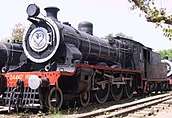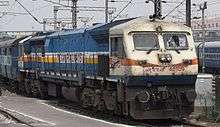Indian locomotive class WDM-3A
The Indian locomotive class WDM-3A is a class of diesel-electric locomotive that was developed in 1993 by Diesel Locomotive Works (DLW), Varanasi for Indian Railways. The model name stands for broad gauge (W), Diesel (D), Mixed traffic (M) engine, with 3300 horsepower (3A). The WDM-3A is a later classification of earlier WDM-2C. They entered service in 1994. A total of 143+ WDM-3A was built at ALCO and Diesel Locomotive Works (DLW), Varanasi between 1994 and 2003 with rest of the 1246 units being rebuild from WDM-2 which made them the most numerous class of mainline diesel locomotive until the WDG-4.
| WDM-3A | |||||||||||||||||||||||||||||||||||||||||||||||||
|---|---|---|---|---|---|---|---|---|---|---|---|---|---|---|---|---|---|---|---|---|---|---|---|---|---|---|---|---|---|---|---|---|---|---|---|---|---|---|---|---|---|---|---|---|---|---|---|---|---|
 WDM-3A of Vatva loco shed | |||||||||||||||||||||||||||||||||||||||||||||||||
| |||||||||||||||||||||||||||||||||||||||||||||||||
| |||||||||||||||||||||||||||||||||||||||||||||||||
| |||||||||||||||||||||||||||||||||||||||||||||||||
| |||||||||||||||||||||||||||||||||||||||||||||||||
The WDM-3A is one of the most successful locomotives of Indian Railways serving both passenger and freight trains for over 26 years. A few WDM-3A units were exported to neighboring countries like Sri Lanka and Bangladesh. Despite the introduction of more modern types of locomotives like WDG-4 and electrification, a significant number are still in use, both in mainline and departmental duties. As of 2020, 1081 locomotives still retain "operational status" on the mainline as WDM-3A, with further examples having been converted back to WDM-2 or WDM-2S. The loco is now widely used across India for long-distance passenger trains due to its ruggedness and high tractive loads and acceleration.
History


.jpg)

The first one was delivered on August 22, 1994, It was then WDM-2C.[1][2] First 57 units produced till March 1996 (Indian Railway road number 14001-14057) had rounded front hood profile similar to contemporary newer classes of locos built by DLW (WDG3A and WDP1). After that there was a gap of long four years in the WDM3A production line in DLW. These units have been retro-fitted with dual brakes, in addition to the air and vacuum brakes. The WDM-3A locos have a maximum speed of 120 km/h (75 mph). The gear ratio is 65:18.[3] These new locomotives had their control stand shifted to the left side of the cabin. Meanwhile, Diesel Loco Modernization Works (erstwhile Diesel Modification Works which again was known as Diesel Component Works) in Patiala started rebuilding the existing WDM2 locomotives, which had reached midlife, with upgraded power-packs. DLMW Patiala re-calibrates the power-pack and upgrades the output power rating to 3100HP.[4] DLW again started building WDM3A from the year 2000 and continued till the end of 2002 with locomotive road numbers in the range 14058–14143. All the locomotives rebuilt by DLMW and later batch from DLW had regular WDM2 type square short hood profile and control stand position. DLW again built WDM3A variant locomotives, during 2005–2006, in the road number range 14144-14167 which were classified as WDM3B due to their difference in bogie design from classic ALCo asymmetrical trimount to HAHS design which was employed in WDG2 and later WDM3D classes too. Most of the WDM3B were later converted to WDM3D. In 2011, DLMW rebuilt locomotive number 16502 as WDM3A and equipped it with an Electronic Fuel Injection (EFI) system jointly developed by Engine Research Laboratory of IIT Kanpur, Engine Development Directorate of RDSO, and DLMW Patiala.[5] DLMW continues to rebuild WDM2 as WDM3A and recently they have started rebuilding the DLW built WDM3A too when they reach their midlife. Recent rebuilt locomotives are rated at 3300 HP, and from 2009 onward they are equipped with Daulat Ram DBR, and since 2014 they are also equipped with an Auxiliary Power Unit (APU) in the short hood.[6] Some rebuilt locomotives have Co-Co-fabricated ATHS (Advanced Trimount High Speed) bogies instead of ALCo cast-iron type.[7] All the rebuilt WDM3A bear the "-R" suffix to their road numbers.
In 2012 Bangladesh Railway ordered 26 WDM3A from DLW. They are classified as Class 6500 there. These units, however, lack the dynamic braking which happens to be an essential component in their Indian counterparts.
Sub Classes
WDM-3C
The WDM-3C were just upgraded and more powerful WDM3As with the ALCO engine gain rebuilt to output 3300 hp. It was the first follow-up experiment after the WDM-3A to squeeze more power out of the ALCO engine, an intermediary that would later lead to the development of the WDM-3D. Not many were produced, all of which were rebuilds of the WDM2 or WDM3A and were identical to the previous variants in every aspect. They can no longer be found over the railway network as all of them have been rebuilt into the WDM-3A or WDM-2 type.[8]
Locomotive sheds
| Zone | Name | Shed Code | Quantity |
|---|---|---|---|
| Central Railway | Pune | PA | 11 |
| Kurla | CLA | 2 | |
| Eastern Railway | Howrah | HWH | 9 |
| Bardhaman | BWN | 50 | |
| Andal | UDL | 8 | |
| Jamalpur | JMP | 28 | |
| East Central Railway | Patratu | PTRU | 17 |
| Mughalsarai | MGS | 20 | |
| Samastipur | SPJ | 32 | |
| East Coast Railway | Visakhapatnam | VSKP | 36 |
| Northern Railway | Tughlakabad | TKD | 34 |
| Ludhiana | LDH | 105 | |
| Lucknow | LKO | 25 | |
| North Central Railway | Jhansi | JHS | 32 |
| North Eastern Railway | Gonda | GD | 99 |
| Northeast Frontier Railway | Malda Town | MLDT | 58 |
| Guwahati | NGC | 15 | |
| North Western Railway | Abu Road | ABR | 68 |
| Southern Railway | Erode | ED | 4 |
| Ernakulam | ERS | 34 | |
| Golden Rock | GOC | 11 | |
| Tondiarpet | TNP | 20 | |
| South Central Railway | Kazipet | KZJ | 12 |
| Gooty | GY | 7 | |
| Guntakal | GTL | 22 | |
| Moula Ali | MLY | 18 | |
| South Eastern Railway | Kharagpur | KGP | 31 |
| Bondamunda | BNDM | 29 | |
| Bokaro Steel City | BKSC | 19 | |
| South East Central Railway | Raipur | R | 26 |
| South Western Railway | Krishnarajapuram | KJM | 22 |
| Western Railway | Ratlam | RTM | 24 |
| Vatva | VTA | 34 | |
| West Central Railway | Itarsi | ET | 56 |
| New Katni Junction | KTE | 47 | |
| Total Locomotives Active as of 01-08-2020[9] | 1065 | ||
Technical specifications
Technical details are as follows:[10][11]
| Manufacturers | DLW, DLMW (DMW/DCW) |
| Engine | Alco 251-C, 16 cylinder, 3,300 hp (2,500 kW), earlier 3,100 hp (2,300 kW) (3,007 hp or 2,242 kW site rating, earlier 2,900 hp (2,200 kW)) with Napier NA2951R/ ABB VTC-304-VG15/ GE 7s 1716 turbo supercharged engine. 1,050 rpm max, 400 rpm idle; 228.6 mm × 266.7 mm (9.00 in × 10.50 in) bore x stroke; compression ratio 12.5:1. Direct fuel injection, centrifugal pump cooling system (2,457 L/min (540 imp gal/min; 649 US gal/min) at 1,050 rpm), fan driven by eddy current clutch (90 hp or 67 kW at 1,050 rpm) |
| Governor | EDC / Woodward 8574-650 |
| Transmission | Electric, with BHEL TA 10102 CW alternator (1,050 rpm, 1100 V, 4,400 amperes) (Earlier used BHEL TG 10931 AZ alternator) |
| Traction motors | BHEL TM 4906 AZ/ 4907 BZ (435 hp or 324 kW) (with roller bearings) |
| Axle load | 18.8 tonnes (18.5 long tons; 20.7 short tons), total weight 112.8 t (111.0 long tons; 124.3 short tons) |
| Bogies | Alco design cast frame asymmetric trimount (Co-Co) bogies |
| Starting TE | 30.45 t (29.97 long tons; 33.57 short tons) at adhesion 27%, continuous 28.05 t (27.61 long tons; 30.92 short tons) |
| Length over buffer beams | 15,862 mm (52 ft 1⁄2 in) |
| Distance between bogies | 10,516 mm (34 ft 6 in) |
See also
References
- "IR History: Part - V (1970-1995)". Indian Railways Fan Club. Retrieved 22 August 2017.
- Agarwal, Avinash Kumal; Dhar, Atul; Gautam, Anirudh; Pandey, Ashok, eds. (2017). Locomotives and Rail Road Transportation - Technology, Challenges and Prospects. Springer. p. 16. ISBN 978-981-10-3787-0. LCCN 2017930134 – via Google Books.
- "About WDM-3A". Indian Railways Fan Club.
- (PDF). Indian Railways http://www.dmw.indianrailways.gov.in/works/uploads/File/Company%20Profile.pdf. Retrieved 2 March 2018. Missing or empty
|title=(help) - "Direction Article Development of EFI for 204-stroke locomotive diesel engine" (PDF). iitk.ac.in. Indian Railways. 2018. Retrieved 2 March 2018.
- "Company Profile" (PDF). indianrailways.gov.in. Indian Railways. Retrieved 2 March 2018.
- "Motive Power" (PDF). indianrailways.gov.in. RDSO. 2018. Retrieved 2 March 2018.
- "Diesel Loco Roaster WDM(ALCO) series".
- "Railway Website Mechanical Department". Retrieved 16 May 2020.
- "Diesel Locomotive Classes – Broad Gauge". Indian Railways Fan Club.
- "Diagram Book of WDM2C Locomotive" (PDF). RDSO.



